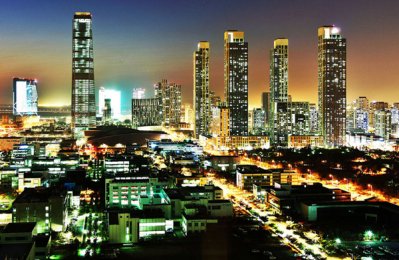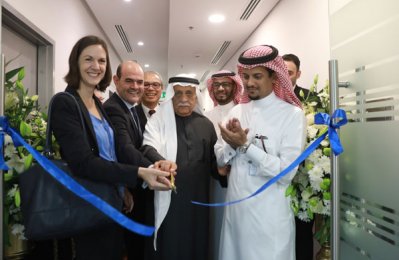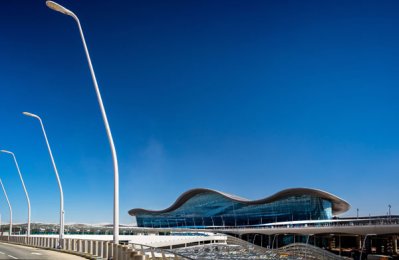Mideast 'making headways in global smart city ambition'
Flourishing PPP (public-private-partnership) infrastructure models and increasing openness towards private sector are providing ample opportunities for investors in the Middle East as it strives to become a smart global hub, said a report.
More Stories
Flourishing PPP (public-private-partnership) infrastructure models and increasing openness towards the private sector are providing ample opportunities for investors across the Middle East as it strives to become a smart and sustainable global hub.
These are among the key findings in the 2019 Infrastructure Index: Bridging Continents compiled by international law firm CMS in conjunction with inspiratia.
The report analyses data against six criteria to create a guide to the most attractive destinations for infrastructure investment in the world.
This year’s report confirms that a crucial point has been reached in the global transition into greener, smarter and more sustainable investments and assets.
Smart cities shaping the Middle East’s future
As private-led investments continue to build across the region, the report shows that the Middle East is making significant headway in becoming a global smart, and sustainable, city hub.
Notable projects include Saudi Arabia’s $500 billion Neom Bay – expected to generate $100 billion in total GDP by 2030; Abu Dhabi’s Masdar City and the Zayed Smart; and Kuwait’s $4 billion South Saad Al Abdullah smart city.
The UAE sits at #13 in the Index, leading the way for the region overall. Projects such as KKR and BlackRock’s $4 billion stake in Abu Dhabi’s National Oil Company’s 750-km-long midstream oil pipeline continue to demonstrate the country’s attractiveness for infrastructure investment.
Saudi Arabia came in second in the region at #21, owing to the country’s increasing openness to international private participation, improved political stability and recent announcement of a USD 425bn boost to Saudi Arabia’s Vision 2030 infrastructure plans, followed by Oman (#34), Kuwait (#35), Turkey (#38), Qatar (#42) and Iran (#50).
Supportive PPP legislation in the UAE, Kuwait, Qatar, Oman and soon Saudi Arabia is also set to increase investor confidence even further and support the region’s economic diversification.
Mark Rocca, Co-Managing Partner, CMS Dubai, said: "The region – collectively and individually – is putting renewable energy at the centre of its growth agenda and to fuel its smart city ambitions. The region continues to provide some of the most ambitious solar and onshore wind projects, closing a pipeline of over 2.8GW in 2019."
"With extensive government reforms opening up the country to further investment and state-led privatisations continuing across the region, the Middle East looks set to continue on its strong growth path," he noted.
Globally, Europe claimed six of the top 10 countries in this year’s Index; Germany overtook the Netherlands to win top spot in the 2019 Index, as it attempts to prioritise sustainability and innovation.
Despite some controversy over whether the government is meeting and setting ambitious enough targets, climate action is very much an essential part of the political agenda. As a result, there are clear opportunities associated with projects to support renewable energy and EV infrastructure.
Elsewhere, notably the Brexit-effect is taking its toll on the UK infrastructure sector as it slips five places to 9th position on the 2019 Index.
The report revealed that Europe was brimming with opportunities in 5G, renewables, airport expansions and electrification of transport as the race towards green leadership and proactive government policies gather pace.
Other findings in the report show:
•Asia Pacific leads in digital transformation: Investment in digital infrastructure is on a general upswing in the Asia Pacific region, with major hubs vying for supremacy in the communications sector. Singapore ranks 3rd in the overall Index, with numerous digital infrastructure investment opportunities backed-up by strong regulatory frameworks and initiatives such as Singapore’s Digital Industry (DISG), an authority dedicated to driving digital infrastructure investments, further bolstering the country’s reputation as Asia’s data centre hot spot. China also shows a significant improvement in the rankings, rising by 10 points since the 2017 index to claim 18th spot, thanks to its considerable 5G efforts. Over 10 million advance orders for 5G data plans were submitted to China’s three mobile operators, and they will deploy a total of 130,000 standalone 5G base stations across the country by the end of 2019.
•LatAm leads innovation across the Americas: Major interconnectivity projects in Latin America mean that the region is leading on innovative digital infrastructure of the future. Examples include a 3,500km-long submarine fibre optic network from the north to the south of Chile and the recently completed 10,000km subsea cable connecting California to Chile. In North America, Canada has maintained its appeal to private and institutional investors through strong PPP procurement activity. Despite high-profile announcements in the US to improve the country’s highways, railways, bridges and broadband, discussions with the government on these issues have come to a halt.
•African trade ambitions boost interconnectivity: Fiscal constraints and limited project finance capabilities may hinder ambitions, but African governments are starting to open their doors to greater private investment to overcome their infrastructure shortfall. East Africa in particular demonstrates strong political will for renewables. Kenyan President Uhura Kenyatta has announced an ambitious programme to move Kenya’s installed renewable energy capacity from 70% to 100% by 2020. A target well within reach due to the 310MW Lake Turkana wind farm, which was connected to the national grid, via the new USD 271m Loiyangalani-Suswa power transmission line, in December 2018.
Kristy Duane, the co-head of Infrastructure and Project Finance at CMS, said: "Infrastructure is connecting people worldwide at an unrelenting pace. With sustainability, innovation and digital transformation at the heart of government agendas, investors are finding new and exciting opportunities on a global scale, including in 5G, subsidy-free renewables, smart cities and PPP in new markets."
"As our 2019 report illustrates, infrastructure assets play a vital role in climate change mitigation, with top-ranked Germany coming under increasing domestic pressure to transform its infrastructure efforts to meet more ambitious targets," stated Duane.
"Environmental, social and governance (ESG) criteria are becoming a top priority for infrastructure investors – however this brings with it challenges as investors navigate a complex matrix of evolving requirements and standards for different assets around the world," he stated.
M&A activity was also an important feature in markets globally in 2019, with developing economies, in particular, investing heavily in roads, rail and airports to drive economic growth and bring them closer to international trading partners, noted Duane.
"Overall, the infrastructure sector continues to present a positive picture in an uncertain world," he added.-TradeArabia News Service
Projects















